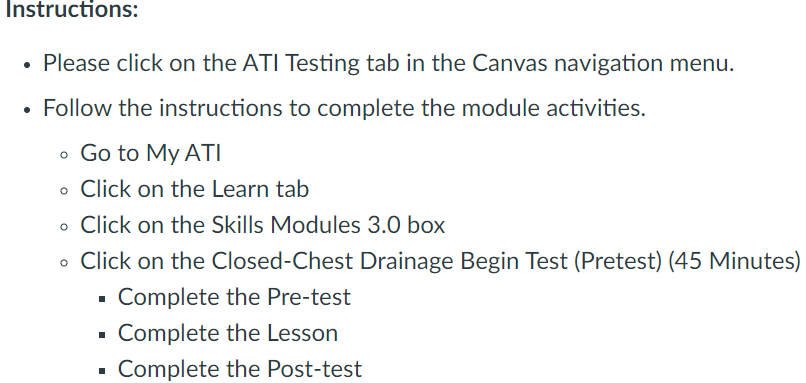NUR105 M3.4: ATI Skills Modules: Closed-Chest Drainage
A nurse is caring for a client who requires a chest tube. The provider asks for the suction pressure of the closed-chest drainage system to be set at -40cm of water. Which of the following closed-chest drainage systems should the nurse prepare for this client? NUR105 M3.4: ATI Skills Modules NUR105 M3.4: ATI Skills Modules
Answer: Dry suction-control system
Explanation: Dry suction-control systems can provide higher suction pressures, making them suitable for cases where more significant suction is required.
Question: A nurse is caring for a client who has a chest tube in place that is attached to water-seal drainage system. Which of the following findings should the nurse recognize as an indication of subcutaneous emphysema?
Answer: A dry, crackling sound at the insertion site when palpated NUR105 M3.4: ATI Skills Modules. NUR105 M3.4: ATI Skills Modules
Explanation: Subcutaneous emphysema is characterized by a dry, crackling sound at the insertion site due to air leaking into the subcutaneous tissue.
Question: A nurse is caring for a client who has a chest tube in place that is attached to a closed-chest drainage system. Which of the following actions should the nurse take if the chest tube becomes dislodged from the closed-chest drainage system? NUR105 M3.4: ATI Skills Modules
Answer: Submerge the end of the chest tube in 1 inch of sterile water
Explanation: Submerging the dislodged chest tube in sterile water creates a water seal to prevent air from entering the pleural space when the client inhales.
Question: A nurse is caring for a client who has a chest tube in place. Which of the following strategies should the nurse use to help promote comfort for the client? NUR105 M3.4: ATI Skills Modules
Answer: Have the client splint the affected side during coughing. NUR105 M3.4: ATI Skills Modules
Explanation: Splinting the affected side during coughing can help minimize pain for a client with a chest tube, in addition to administering pain relief as needed.
Question: A nurse is preparing to transport a client who has a chest tube and a closed-chest wet-suction drainage system to radiology. Which of the following actions should the nurse take when detaching the suction source for transportation?NUR105 M3.4: ATI Skills Modules
Answer: Make sure the air vent is open NUR105 M3.4: ATI Skills Modules
Explanation: The air vent in the water-seal chamber should be open to maintain proper functioning of the drainage system when disconnecting the suction source.
Question: A nurse is assessing a client 5 hr after the insertion of a chest tube that is attached to a water-seal drainage system. Which of the following observations about the drainage should the nurse report to the provider?
Answer: About 150 mL/hr drainage over the past 2 hr
Explanation: Drainage exceeding 70 mL/hr should be reported after the initial hours following chest tube insertion, as it may indicate a significant issue or bleeding.
Question: A nurse is caring for a client who is 6 hr postoperative and has a chest tube in place that is attached to a closed-chest water-seal drainage system. The nurse should identify that which of the following is an indication of a problem in the drainage system?
Answer: Continuous bubbling in the water-seal chamber
Explanation: Continuous bubbling in the water-seal chamber indicates an air leak in the drainage system, which should be addressed promptly.
Question: A nurse is planning education for a client who has a chest tube in place that is attached to a closed-chest drainage system. Which of the following instructions should the nurse plan to provide when the client is ready to ambulate?
Answer: Keep the collection device upright at all times
Explanation: To ensure the proper functioning of the closed-chest drainage system, the collection device must be kept upright at all times.
For those looking for assistance with ATI testing or the NCLEX exam for nursing, I urge you to consider our services at fixmygpa.com. We offer comprehensive support to help you excel in your nursing education and exams. Our expert team can provide the help you need to succeed and confidently pass your ATI and NCLEX exams. Don’t hesitate to reach out and take the next step towards your nursing career!



